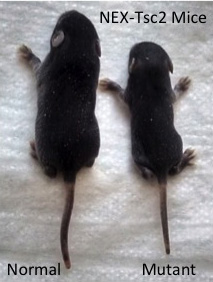Tuberous Sclerosis Complex
Loss of Tsc2 and Increased mTORC1 Signaling in Excitatory Neurons Lead to Complex Abnormalities
Posted May 12, 2016
Gabriella D'Arcangelo, Ph.D., Rutgers, The State University of New Jersey
 Tuberous Sclerosis Complex (TSC) is a multifaceted genetic disease, which through loss of either of the TSC1 or TSC2 genes, imparts tumor susceptibility, cognitive dysfunction, epilepsy, and/or autism in patients. TSC1 and TSC2 proteins function to inhibit mammalian target of rapamycin complex 1 (mTORC1) signaling, preventing signals that among other things, instruct cells to grow and divide. However, the exact signaling pathways involved in cognitive impairment are unclear. Previous studies had shown that a protein important in cognition, the NMDA neurotransmitter receptor, was altered in patients with TSC. Dr. Gabriella D'Arcangelo had the idea that the protein phosphatase and tensin homolog (PTEN), which can affect N-methyl-D-aspartate (NMDA) receptor expression, may also be lost in the affected cells from these patients, explaining the cognitive dysfunction observed. Dr. D'Arcangelo was awarded a Tuberous Sclerosis Complex Research Program (TSCRP) Fiscal Year 2011 (FY11) Exploration - Hypothesis Development Award to study the interactions between these proteins in an animal model of TSC. She hypothesized that loss of Tsc2 could alter NMDA receptor expression through a mechanism that involved Pten downregulation, rather than changes in mTOR signaling. However, the findings pointed to a mechanism for Pten control of NMDA receptor expression independent of Tsc2/mTOR signaling and suggested that NMDA receptor abnormalities do not play a central role in cognitive defects in TSC patients.
Tuberous Sclerosis Complex (TSC) is a multifaceted genetic disease, which through loss of either of the TSC1 or TSC2 genes, imparts tumor susceptibility, cognitive dysfunction, epilepsy, and/or autism in patients. TSC1 and TSC2 proteins function to inhibit mammalian target of rapamycin complex 1 (mTORC1) signaling, preventing signals that among other things, instruct cells to grow and divide. However, the exact signaling pathways involved in cognitive impairment are unclear. Previous studies had shown that a protein important in cognition, the NMDA neurotransmitter receptor, was altered in patients with TSC. Dr. Gabriella D'Arcangelo had the idea that the protein phosphatase and tensin homolog (PTEN), which can affect N-methyl-D-aspartate (NMDA) receptor expression, may also be lost in the affected cells from these patients, explaining the cognitive dysfunction observed. Dr. D'Arcangelo was awarded a Tuberous Sclerosis Complex Research Program (TSCRP) Fiscal Year 2011 (FY11) Exploration - Hypothesis Development Award to study the interactions between these proteins in an animal model of TSC. She hypothesized that loss of Tsc2 could alter NMDA receptor expression through a mechanism that involved Pten downregulation, rather than changes in mTOR signaling. However, the findings pointed to a mechanism for Pten control of NMDA receptor expression independent of Tsc2/mTOR signaling and suggested that NMDA receptor abnormalities do not play a central role in cognitive defects in TSC patients.
In the process of performing these studies, Dr. D'Arcangelo and her lab members generated novel brain-specific Tsc2 conditional knockout mice, NEX-Tsc2 mice, in which the Tsc2 gene is deleted in excitatory neurons of the developing forebrain. While mice that have one functional copy of the gene appeared normal, mice with loss of both copies of Tsc2 were runt and had a dramatically shortened lifespan. The mice lacking Tsc2 exhibited abnormalities in their brain structure, including enlarged neuronal cells, specific neuronal cells not in the proper location within the brain, and increased numbers of another cell type, astrocytes, in the cortical region of the brain. These abnormalities resulted from increased mTORC1 signaling, either from increased signaling within the neuronal cells or, in the case of the astrocytes, signals sent to other cell types by the neuronal cells. Interestingly, all of the abnormalities observed in these mice could be treated with the mTORC1 inhibitor RAD001. The mice lacking Tsc2 treated with RAD001 were no longer runt compared to normal drug treated mice, and survival was dramatically increased. Thus, the results show that increased mTORC1 signaling as a result of loss of Tsc2 in excitatory neurons in the forebrain underlies developmental disruptions in neuronal cells and astrocytes via intrinsic signaling in the former and extrinsic signaling in the latter.
Based on these findings, Dr. D'Arcangelo applied and was recommended to receive an FY15 Idea Development Award from the TSCRP to continue her studies in the pathogenesis of this disorder. Dr. D'Arcangelo and her lab members believe that this basic knowledge can be translated into better treatments and can ultimately improve the lives of TSC patients. We look forward to more exciting results from the D'Arcangelo lab.

Appearance of normal and homozygous mutant NEX-Tsc2 littermates at postnatal day 9. The mutant mouse appears runt.
Publications:
Crowell B, Lee GH, Nikolaeva I, Dal Pozzo V, and D'Arcangelo G. Complex Neurological Phenotype in Mutant Mice Lacking Tsc2 in Excitatory Neurons of the Developing Forebrain. 2015. eNeuro 2(6). pii: ENEURO.0046-15.2015. doi: 10.1523/ENEURO.0046-15.2015.
Links:














